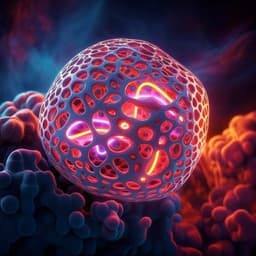
Chemistry
Flash healing of laser-induced graphene
L. Cheng, C. S. Yeung, et al.
Discover how Le Cheng and colleagues have revolutionized laser-induced graphene (LIG) fabrication with a novel flash Joule heating method, significantly boosting conductivity and performance in soft electronics. This advancement promises exciting applications in low-voltage disinfection and sensor technology.
Playback language: English
Introduction
Graphene, a two-dimensional material with exceptional properties, has seen various synthesis methods developed, including chemical vapor deposition, liquid-phase exfoliation, and reduction of graphene oxide. However, these methods often involve limitations like specialized equipment, harsh chemicals, high energy consumption, and labor-intensive processes. Laser-induced graphene (LIG) emerged as a significant advancement, offering a bottom-up approach for scalable graphene production using commercial laser cutting machines. LIG's high porosity, flexibility, and cost-effectiveness make it attractive for diverse applications in electronics, catalysis, and sterilization. The ultrafast kinetics of laser irradiation, however, result in predominantly amorphous structures with high resistivity, limiting performance in electronic devices. Conventional methods for healing graphene defects, such as bulk heating and chemical reduction, are unsuitable for LIG patterns. Bulk heating can damage the patterns, and chemical reduction cannot induce the necessary atom rearrangements for improved crystallinity. This study explores flash Joule heating (FJH) as a solution, leveraging its speed and localized heating to potentially rectify topological defects in LIG patterns without damaging the overall structure and porosity. The researchers hypothesized that FJH could facilitate atomic-level reorganization, leading to improved crystallinity and conductivity in LIG.
Literature Review
The literature extensively covers graphene synthesis methods, highlighting the limitations of traditional techniques and the advantages of LIG. Several studies detail LIG fabrication using various laser sources (IR, visible, UV) and their impact on graphene structure. While LIG's amorphous nature is beneficial in applications like energy storage and electrocatalysis, its poor conductivity restricts its use in electronics. Existing defect healing methods, including high-temperature annealing and chemical reduction, have been shown effective for graphene films and powders but are unsuitable for patterned LIG due to the potential for damage. Previous work demonstrates the use of FJH in fabricating and processing carbon materials, showing promising results in welding carbon nanofibers and enhancing graphitization. However, these studies primarily focus on bulk material production and lack the patterning control needed for targeted defect healing in LIG. This paper builds upon this foundation, aiming to demonstrate the feasibility and effectiveness of FJH as a novel method for improving LIG's structural and electrical properties.
Methodology
The study employed a two-step process for fabricating flash Joule heated LIG (F-LIG). First, LIG patterns were scribed onto a polyimide (PI) film using a CO2 laser cutting platform. Then, flash Joule heating (FJH) was applied using a programmable switching power supply in a vacuum chamber. Dumbbell-shaped patterns were used to ensure consistent heating at the thinner middle section. Silver paste provided reliable electrical contact. The impact of FJH was investigated by applying different voltages (150-190V) with a 20ms pulse duration. The resulting flash of black-body radiation was observed and temperatures were measured using an IR thermometer. Resistance measurements were taken before and after FJH treatment. Instantaneous voltage, current, areal power density, and areal energy density were recorded to analyze the FJH process. The structural characterization of LIG and F-LIG was performed using Raman spectroscopy, which was used to determine the ID/IG ratio, crystalline size (La), 2D band FWHM, and I2D/IG ratio. High-resolution transmission electron microscopy (HRTEM) and X-ray pair distribution function (PDF) analysis were conducted to examine the atomic-scale morphology and interatomic distances. X-ray photoelectron spectroscopy (XPS) was utilized to analyze the elemental composition and atomic binding states. Scanning electron microscopy (SEM) provided images of the microstructure. The adaptability of the FJH technique was assessed by testing it on LIG patterns with different shapes, sizes, and substrates (polyethersulfone (PES), poly(ether-ether-ketone) (PEEK), and PES/lignin). The effect of pulse duration on the FJH process was also investigated. For strain sensor fabrication, LIG and F-LIG patterns were transferred to polydimethylsiloxane (PDMS) substrates. Electromechanical tests, including cyclic bending and tensile tests, were performed using an Instron UTM system to evaluate the sensor's performance. The gauge factor (GF) was calculated to assess the sensitivity. Human motion detection, phonation recognition, and robotic hand control were demonstrated using the F-LIG-based strain sensors. Low-voltage sterilization experiments were conducted using E. coli as a model bacterium. Colony-forming unit (CFU) assays were performed to assess the antibacterial properties of LIG and F-LIG under different voltages.
Key Findings
Flash Joule heating (FJH) significantly improved the properties of laser-induced graphene (LIG). Raman spectroscopy revealed a decrease in the ID/IG ratio (from 0.84 to 0.33 for F-LIG-190V), indicating a reduction in defect density and an increase in crystalline domain size (from 22.9 nm to ~60 nm). The 2D band exhibited sharpening and narrowing, suggesting improved structural quality and reduced stacking. HRTEM imaging showed a transformation from disordered atomic arrangement in LIG to a highly ordered hexagonal carbon lattice in F-LIG. PDF analysis confirmed a shorter C-C bond length (1.425 Å) and broader-range order in F-LIG. XPS analysis showed an increase in carbon content and a reduction in oxygen content after FJH treatment. The conductivity of F-LIG increased fivefold compared to LIG, with a resistance reduction of up to 80%. The F-LIG/PDMS strain sensor displayed a gauge factor of 129.3 within 10% strain, outperforming pristine LIG by 800%. The sensor exhibited high sensitivity, negligible hysteresis, and excellent stability, making it suitable for detecting subtle human motions, phonation, and wrist pulses. The F-LIG-based smart glove successfully controlled a robotic hand, demonstrating its potential for human-machine interfaces and information encryption. F-LIG also showed enhanced bacterial killing properties under low voltages (99.94% efficiency at 5V for E. coli), surpassing LIG's performance.
Discussion
The findings demonstrate the effectiveness of flash Joule heating as a method for improving the quality and performance of laser-induced graphene. The significant improvements in crystallinity and conductivity, as confirmed by multiple characterization techniques, directly address the limitations of traditional LIG. The enhanced performance of the F-LIG-based strain sensor showcases its potential for a wide range of applications, particularly those requiring high sensitivity in low strain ranges. The success in using the F-LIG sensor for human-machine interface applications, including robotic hand control, further highlights its practical applicability. The improved antibacterial properties of F-LIG under low voltages suggest promising applications in sterilization and healthcare. The results significantly contribute to the field by providing a novel and efficient technique for improving LIG's properties and expanding its application potential.
Conclusion
This study successfully demonstrated the efficacy of flash Joule heating (FJH) in healing defects within laser-induced graphene (LIG), resulting in significantly enhanced conductivity and performance. The resulting F-LIG material showed remarkable improvements in various applications, including high-sensitivity strain sensors for human-machine interfaces and low-voltage sterilization. Future research could focus on optimizing the FJH parameters for various LIG precursors and exploring additional applications of F-LIG in energy storage, catalysis, and other areas.
Limitations
While the study demonstrated significant improvements, some limitations exist. The dumbbell shape of the LIG samples used for FJH was designed for consistent heating; investigating the effect on arbitrarily shaped LIG patterns requires further research. The study primarily focused on E. coli; testing against a wider range of bacteria and viruses is necessary to confirm the broad applicability of F-LIG for sterilization. The long-term stability of the F-LIG-based sensors under extreme environmental conditions could be further investigated. Finally, the scalability of the FJH process for industrial applications needs to be explored.
Related Publications
Explore these studies to deepen your understanding of the subject.







